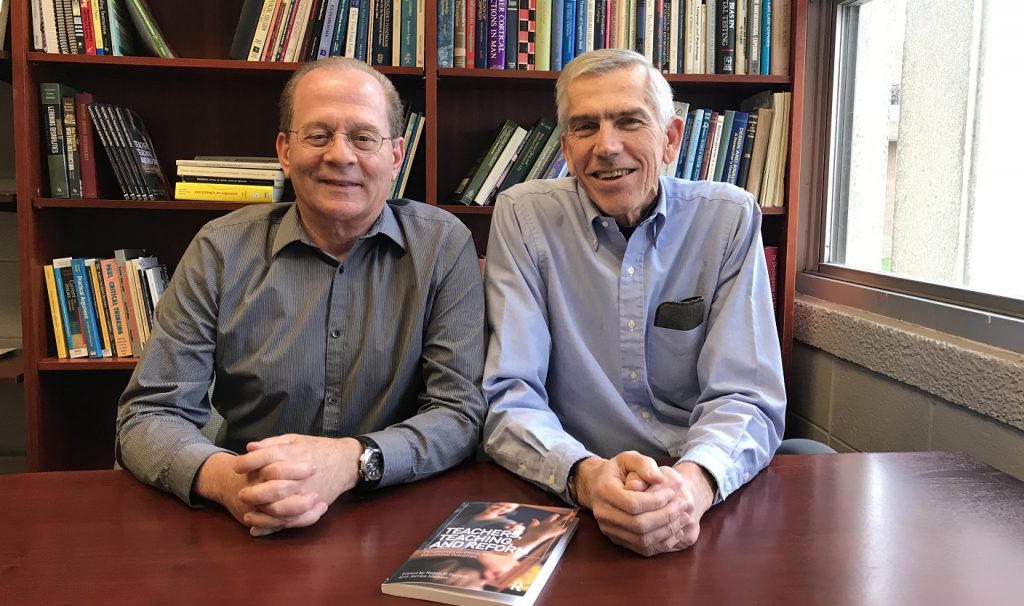School of Education
Ferretti and Hiebert publish new collection on Teachers, Teaching, and Reform

Book advocates reforming education through collaborative decision-making
Since the publication of A Nation at Risk, education reform has centered on teacher accountability, with administrators, policymakers, and researchers determining how teachers teach and how to best measure teachers’ efficacy and productivity.
Ralph P. Ferretti, professor in the School of Education (SOE) and the department of Psychological and Brain Sciences, and James Hiebert, Robert J. Barkley Professor in the SOE, have published a timely, edited collection titled Teachers, Teaching, and Reform: Perspectives on Efforts to Improve Educational Outcomes, highlighting a different approach. To improve student outcomes, they encourage a process of collaborative decision-making in which teachers and administrators set goals, analyze the outcomes, and modify their instructional strategies accordingly.
We sat down with the editors to learn about the book and its value for education faculty, administrators, and policymakers.
What inspired this project?
American education has been in a nearly constant state of reform since Horace Mann’s efforts to institutionalize public education and teacher training in the early nineteenth century. Despite these efforts, what counts most in schools—the nature of classroom teaching—has changed very little.
With the publication of A Nation at Risk in 1983, an aggressive reform agenda emerged that focused on teachers as the primary cause of poor educational outcomes. Since then, reform has focused on personnel strategies designed to select teachers who have the right stuff, cull out those who don’t, and incentivize better behavior.
In our view, systematic progress has been stymied by this approach. The evidence shows that teaching still hasn’t changed, and that teachers and administrators feel increasingly alienated from their work. This isn’t a recipe for promoting good outcomes for kids, and we provide other perspectives in this book.
You give an historical overview of educational reform, tracing the development of two competing models adopted from industry: one that centers on improving the quality of the teacher and another that centers on improving the system in which the teacher works. How would these models affect a teacher?
The current focus on teacher accountability is an artifact of the nineteenth century “scientific management” movement, spearheaded by Frederick Taylor, designed to improve worker efficiency and productivity. This model establishes a hierarchy of expertise and authority, with teachers carrying out the directives of administrators, policymakers, and researchers. Often, teachers are trained in the processes they should use and have little say about the assessments used to judge their work.
By contrast, Edward Deming, the founder of continuous improvement, believed that management should create conditions that enable the system to achieve shared, organizational goals. Rather than focusing on personnel shortcomings, this model focuses on the design and continuous improvement of work processes. Decision-making is collaborative and involves the workers.
This model turns many cultural assumptions upside down in U.S. schools. Teachers join district leaders and educational researchers in setting learning goals for students, making decisions about curricula and assessments, and designing feedback processes that help everyone in the system improve their practices. Teachers are given time to work together to improve their teaching, along with the responsibility to demonstrate progress over time. Expectations shift from quick reform to incremental, steady, and lasting improvement.
Recognizing that neither model has led directly to improvement, you instead argue for a version of the continuous improvement model and offer UD’s mathematics elementary teacher education program as one example. What does this approach look like?
For nearly two decades, our mathematics education colleagues have worked to improve the quality of lessons designed to prepare future mathematics teachers. Borrowing elements from a Japanese process known as “lesson study,” this work began with discussions about the lesson’s goals and the teaching methods designed to achieve them.
The process also included decisions about the data that would be used to assess progress, and how the data would be used to change individual lesson plans. This wasn’t done just one time. Year after year, the faculty reviewed goals, analyzed data, and revised instructional strategies.
The process has been extremely effective in this setting, partly because instructors had the authority to set the learning goals, determine the curriculum, and experiment with better teaching methods. They also could create time to meet weekly, plan future lessons, and review data from previous lessons.
Though you argue for this model, your book offers diverse and even contrasting perspectives on reform. Why was this range important to you?
We thought that readers would benefit from understanding the historical factors that have influenced past and present efforts to improve educational outcomes.
The collection also shows growing dissatisfaction with “business as usual” in education. There seems to be a consensus that progress will require a sustained, collaborative commitment to studying and improving teaching and the systems that support it. If stakeholders have the patience for this approach, we’re optimistic about change.
How has this project changed your thinking?
One of our friends was recently bemused by a comment about being “in a process of becoming.” We’ve become wary of people who propose quick fixes and glib solutions to educational challenges.
Schools are complicated cultural institutions, and change requires a long-term commitment of everyone in the community to the processes of goal-directed, evidence-based, collaborative decision-making.
Article and photo by Jessica Henderson.



